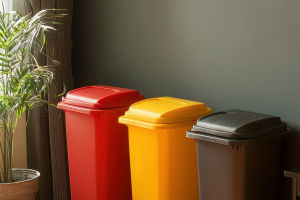
Lykkers, have you ever stood by the trash bins in the U.S., staring at the different colors and wondering where to throw your waste? It's okay! Many of us have been there. But don't worry—today we're going to dive into how to properly sort and recycle trash at home and in public spaces.
Knowing the right way to do it makes a big difference in protecting our environment!
Trash Sorting at Home
Single-Family Homes
If you live in a house, you'll need to contact your local garbage collection company to set up trash service. Once the service is active, they'll deliver bins of different colors—usually a trash bin, a recycle bin, and a yard debris bin. These bins have specific rules about what you can and cannot put in them. Each city or company may have slightly different guidelines, so always double-check the materials you can throw away or recycle.
For example, in many areas, trash and recycling get picked up weekly, while yard waste might be collected every other week. Most homeowners put their bins out on Sunday night so that the garbage company can collect them Monday morning. If you have large or bulky items that don't fit into your bin, you may need to schedule a special pickup, which might cost extra.
Apartments and Condos
For those living in apartments, things are easier. Apartment buildings usually have large community trash and recycling bins. All you need to do is separate your recyclables and trash at home and place them in the right bins. Be sure to check what items are accepted for recycling in your area, as some materials may not be allowed.
Common Household Recyclables
1. Paper
Newspapers, magazines, mail, and printing paper can all go into the recycling bin. Envelopes with clear plastic windows are also fine. If you have shredded paper, it's best to put it in a paper bag before recycling.
2. Cardboard
Flatten all cardboard boxes, like delivery packages and food boxes, before placing them in the recycle bin. Remember to remove any plastic tape or packaging materials first.
3. Plastic
Plastics with the recycling symbol #1 to #7 are generally accepted. This includes yogurt containers, water bottles, milk jugs, and detergent bottles. Wash them clean before recycling, and keep bottle caps separate when possible.
4. Metal
Clean aluminum cans, tin cans, and even foil pans can go into the recycle bin. For cans with lids, push the lid inside to prevent accidents.
5. Glass
Clean glass bottles and jars should be placed in a separate bin or container for glass recycling. In some areas, glass recycling is collected separately from other recyclables.
Items That Can't Go in the Recycling Bin
1. Appliances
Old electronics and large appliances need special handling. Some stores offer trade-in programs where you can exchange old electronics for a discount or cash. If you're buying a new appliance from stores like Home Depot or Lowe's, they may haul away the old one for free.
2. Batteries
While regular alkaline batteries can be thrown away as trash, rechargeable and other types of batteries contain harmful chemicals and should be recycled properly. Websites like Earth911 or Call2Recycle can help locate battery recycling locations near you.
3. Electronics
Old phones, laptops, and other electronics can be recycled through specialized programs. Many brands offer upgrade programs that allow you to trade in old devices for credit toward a new one.
4. Hazardous Waste
Items like light bulbs, paint cans, motor oil, and antifreeze need special disposal. They can't be placed in the regular trash or recycling bin. Check with your local waste disposal site to safely discard these materials.
5. Aerosol Cans
Empty aerosol cans may be accepted in some areas, but many places treat them as hazardous waste. Be sure to confirm with your local waste management company.
6. Broken Glass
Do not put broken glass in the recycling bin to avoid injuring workers. Similarly, glass cookware, mirrors, and ceramics cannot be recycled with regular glass.
7. Contaminated Paper Products
Pizza boxes, paper towels, napkins, and paper plates can't be recycled if they have food residue. However, they can go into a compost bin if your area offers composting services.
8. Plastic Bags and Foam
Plastic bags, plastic wrap, and foam containers are not accepted in most curbside recycling programs. Instead, take them to designated drop-off locations.
Deposit Bottle Recycling
In some states, beverage containers like plastic bottles, aluminum cans, and glass bottles have a small deposit fee. You can return these containers to designated recycling stations and get a refund. Look for labels like “CA CRV” or “NY 5¢” on the bottle to know if your state has a bottle deposit law.
Yard Waste and Debris
For those with gardens, yard waste like grass clippings, leaves, and small branches go in the yard debris bin. However, construction materials like wood and soil cannot be mixed with yard waste.
Trash Sorting in Public Spaces
Public Recycling Bins
When we're out and about, it's important to continue practicing good recycling habits. Many public areas like parks, malls, and campuses now offer separate bins for recycling and trash.
Commonly Accepted Public Recyclables
• Plastic Bottles: Make sure the bottles are empty before recycling.
• Cans: Empty and rinse any remaining liquids.
• Cardboard and Paper: Flatten boxes before disposal.
Compost in Public Spaces
Some public spaces also offer compost bins for food scraps, napkins, and compostable packaging. If a bin is labeled as “compost,” only place organic materials inside.
Public Trash Bins
If you're unsure where something belongs, it's always safer to put it in the regular trash. This helps prevent contamination of recyclable materials.
Practice Makes Perfect
Trash sorting may feel overwhelming at first, but the more we practice, the easier it becomes. Get familiar with your local waste management rules and encourage others to do the same. Together, we can protect our planet by reducing waste and recycling right!


